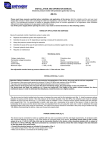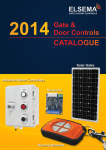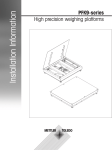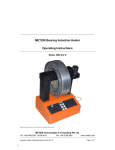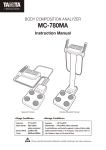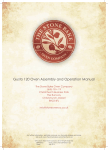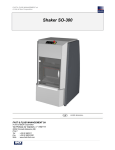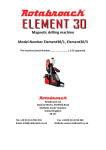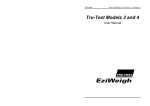Download existing revised bill remarks 1. Extent of Application
Transcript
existing revised bill remarks 1. Extent of Application 1. Extent of Application This standard applies to a scooter This which is a riding instrument with two requirements, wheels. But this standard excludes detail indications, etc. those standard excludes those with non with non bearing-attached wheels or those run by fuelled motor, standard Modification defines test safety methods, of Words and But this bearing-attached wheels or those run by fuelled motor, <Newly established> Statement of 2. Related Specifications The specifications shown below comprise some parts of regulations of this standard as quoted in related standards this standard. These quoted specifications should be latest version. KS A 0006 Normal conditions of testing place KS M ISO 868 Plastic and ebonite – measurement of Shore hardness by durometer KS M 3824 Test method of polyurethane thermoplastic elastomer KS D 9502 Testing method of Salt water spray <Newly established> 3. Definition Statement of Major terms used in this standard are definition as follows: 3.1 Scooter A moving instrument which can be moved by the force of kicking with one foot against the ground while one foot on the board. This is composed of more than 2 wheels, one board on which one can place one foot or feet, and a handle for steering. This is also called scooter. 3.2 Foot Plate existing This is a flat plate on which one can revised bill place one foot or feet. Comparison Table of New and Old Standards for Scooter remarks 2. Type 4. Type Omitted Same as existing 3. Safety Requirements 5. Safety Requirements 3.1 Outer Appearances 5. 1 3.1.1 ~ 3.1.2 Omitted Same as the existing bill Outer Appearances Modification of Words 3.1.3 On the plate, there should be no projecting objects which can cause foot injuries. 3.1.4 ~ 3.1.5 Omitted 3.2 Structures 5.2 Structures 3.2.1 Handlebar should not exceed the <Deleted> vertical line of the ground contact point of the front wheel, and its skew, when pulled with the power of 300N back and forth for 10 seconds, should be less than 10mm. 3.2.2 Handlebar should not break away <Deleted> KS G 5755 incorporated when pulled with the power of 300N vertically. 3.2.3 Grip should be covered with 5.2.1 Grip should be covered with coating materials such as Urethane, coating materials such as Urethane, sponge, etc. and should not break sponge, etc. away when pulled with the power of 10N. 3.2.4 ~ 3.2.7 Omitted 5.2.2 ~ 5.2.5 Same as the existing bill 3.3 Performances 5.3 Performances KS G 5755 3.3.1 weight-proof <Deleted> incorporated 5.3.1 Handle Test KS G 5755 When tested according to 6.3, there incorporated There should be no skews on foot plate, wheels, and folding parts when tested according to 4.2. <Newly established> should be no deformation, separation, visible cracks, or faults. 5.3.2 Foot Plate Test When tested according to 6.4, there should be no deformation, separation, visible cracks, or faults. 3.3.2 ~ 3.3.8 Omitted 5.3.3 ~ 5.3.9 Same as the existing KS G 5755 3.3.9 Grip Retention Strength bill incorporated When tested according to 4.9, grip <Deleted> should not break away. existing revised bill remarks 3.3.10 Stability of Folding Parts 5.3.10 Stability of Folding Parts When tested according to 4.10, they When tested according to 6.11, there should not be folded. should be no abnormalities in use such as folding, etc. 3.3.11 Handle Skew Strength When tested according to 4.11, there should be no abnormalities such as <Specified in 5.3.1> skews. KS G 5755 3.3.12 Braking Power 5.3.11 Braking Power When tested according to 4.12,1, if the When tested according to 6.12, there weight increases to 12, 15, 18kg, the should be no movement longer than braking 7mm. power should increase accordingly and the braking power at weight of less than 15kg should be between 40N and 120N. 3.3.12.2 Hand Brake When tested according to 4.12,2, if the weight increases to 6, 8, 9kg, the braking power should increase accordingly and the braking power at weight of less than 8kg should be between 30N and 80N. 4. Test Method 6. Test Method <Newly established> 6.1 General Condition of Tests 6.1.1 Temperature and Conditions of Test Locations Humidity incorporated Tests should conditions be with performed the in temperature (20±15°C) and humidity (65±20°C) as specified in KS A 0006. 6.1.2 Test Object KS G 5755 If not otherwise specified, test object incorporated should be a project fully assembled according to manufacturer’s user manual. 6.1.3 Tolerance If not otherwise specified, tolerance of power and speed should be ±5%, that of mass ±0.5%, and that of size ±0.5mm. existing revised bill remarks 4.1 Outer Appearances and Structure 6.2 Outer Appearances and Structure Can be checked by the naked eye and Can be checked by the naked eye or by touch. For size measurement, use a can be felt by hand. Alternatively, can Vernir Caliper. For force measurement, be checked with some manipulations use push pull gauge, etc. of the product. 4.11 Handle Skew Strength 6.3 Handle Test Place handle at its furthest position and 6.3.1 Handle/Handlebar Compression place a weight of 30 kg at the centre of Test the handle in the forwards direction of 6.3.1.1 Fix handle at its furthest KS G 5755 the scooter as shown in [Figure 5] for 5 position according to manufacturer’s incorporated minutes. user manual. 6.3.1.2 Place a static weight of 45kg on the upper centre of the handlebar incrementally for 5 seconds - 10 seconds. 6.3.2 Handle/Handlebar Fatigue Test 6.3.2.1 Fix foot plate and front wheel so that they will not swing right or left. 6.3.2.2 Put 7Nm torque at both ends of grip vertically 45° upward/rearward and then downward/forward. 6.3.2.3 Repeat 5,000 cycles of above 6.3.2.2 work while keeping 1 cycle from exceeding 1 second. 6.3.3 Grip/Handle Retention Test Place the weight of 70N on the grip in 4.3 Weight-proof Test the axial direction of the handlebar Place weight of 210kg (20cm x 20cm) incrementally for 5 seconds - 10 vertical to the centre of the upper seconds. surface of the foot plate for 10 minutes. <Deleted> existing <Newly established> revised bill remarks 6.4 Foot plate Test Place a 15cm x 15cm wooden block on the point on the upper surface which is equidistant between front wheel and rear wheel. Place a weight 3 times heavier than the maximum acceptable weight set by the manufacturer, or, if no such maximum weight specified, a static weight of 270kg. 4.3 Driving Test 6.5 Driving Test KS G 5755 For forward driving, drive with 700N Drive 15km at 10km/h speed, while incorporated weight, at 10km/h speed. For reverse placing 700N weight at the centre of driving, drive 2km with 700N, 10km/h. gravity of the foot plate. 4.4 Wheel Hardness 6.6 Wheel Hardness 4.4.1 Polyurethane Materials 6.6.1 Polyurethane Materials 4.4.1.1 Test Piece 6.6.1.1 Test Piece Thickness of test piece shall be thicker Same as the existing bill than 6mm so that it will not be affected by other materials. If any test piece is not thicker than 6mm, fold it to make it thicker than 6mm. The measured surface of the test piece should be flat and even, having a sufficient space to accommodate the pressure-applying surface of test equipment. 6.6.1.2 Test Equipment 4.4.1.2 Test Equipment Use spring type, hardness test Use spring type, hardness test equipment type A as test equipment. In equipment type A as test equipment. case the hardness measured by this In case the hardness measured by test equipment is above 95, then use this test equipment is above 90, then durometer specified in KS M 3043 use Type D durometer specified in KS (Test method for measuring plastic M ISO 868. hardness by durometer). 4.4.1.3 ~ 4.4.1.5 Omitted 6.6.1.3 ~ 6.6.1.5 Same as the existing bill 4.4.2 Rubber Material 6.6.2 Rubber Material 4.4.2.1 Test Piece 4.4.2.1 Test Piece Omitted Same as the existing bill existing revised bill 6.6.2.2 Test Equipment 4.4.2.2 Test Equipment Use spring equipment remarks type hardness test Use spring (Shore hardness test equipment type hardness test (Shore hardness test equipment) as shown in [Figure 2]. equipment) as shown in [Figure 2]. When the pressure-applying surface of When the pressure-applying surface this test equipment is in contact with of this test equipment is in contact KS G 5755 the surface of test piece, the needle with the surface of test piece, the incorporated pressured by the spring in the hole at needle pressured by the spring in the the centre of the pressure-applying hole at the centre of the pressure- surface shows the distance rebounded applying surface shows the distance by the rubber surface in graduations. rebounded by the rubber surface in graduations. a) Pressure-applying surface is a flat and even surface which is vertical to the pressing needle, having a hole which can accommodate and slide the needle as shown in Figure 3. Its diameter should be above 10mm. b) Material of the pressing needle should have corrosion anti-wear properties and anti- and its appearance and size are as shown in Figure 3. The needle should be attached properly at the centre of the hole in the pressure-applying surface. When graduation shows 0, the tip of the needle should protrude 2.49~2.54mm above the pressureapplying surface and when graduation shows 100, the tip of the needle should be placed in line with the pressure-applying surface c) The tolerance of Figure 4 which serves as a guide line for the relationship between graduation, the movement of the pressing needle, and the force of the spring is ±8g. d) Graduation should be evenly marked from 0 to 100. 4.4.2.3 Test Method Omitted 6.6.2.3 Test Method Same as the existing bill 4.5 ~ 4.6 Omitted existing 6.7 ~ 6.8 Same as the existing bill revised bill remarks 4.7 Impact Strength 6.9 Impact Test KS G 5755 Place a weight of 100kg on foot plate, 6.9.1 Put the maximum weight set by incorporated crash it into a 50mm high, hard sill 3 manufacturer, or, if there is no such times at 2m/sec. set weight, a weight of 90kg on the centre of foot plate. 6.9.2 Crash it into a 15cm high, hard sill at 2m/sec. 6.9.3 Repeat above 6.9.2 three times. 4.8 Drop Strength 6.10 Drop Test Place a weight of 500kg on the upper 6.10.1 Put the maximum weight set surface of foot plate, then drop the by the manufacturer, or, if there is no scooter from a 30cm height onto a such set weight, a weight of 90kg on concrete surface 3 times. the centre of the foot plate. 6.10.2 At a height of 15cm from the floor, drop the scooter with one wheel landed. Then, drop the scooter with the other wheel landed at a height of 30cm. 6.10.3 Repeat above 6.10.2 three times. 6.10.4 With the other wheel, repeat the above 6.10.2 and 6.10.3 4.9 Grip Retention Strength <Deleted> Activate joint parts like pin, etc. 10 times successively, the pull the grip apart with the force of 10N by using the spring gauge, etc. when there is a possibility of twisted separation, then twist and pull the grip for test purposes. 4.10 Safety of Folding Parts 6.11 Safety Test of Folding Parts Release locking lever and place handle 6.11.1 Stretch scooter to use position at the furthest position and place a as specified in user manual. weight of 25kg at the most easily 6.11.2 Put together scooter for use in folding point of the upper part of handle the for 5 minutes. manufacture folding way recommended so function that the should by normal not be hindered (releasing locking lever for folding parts). existing revised bill remarks 6.11.3 Place a weight of 880 N at the KS G 5755 position incorporated related normal folding function in the direction of folding according to manufacturer’s manual. Incrementally apply the weight within 5 seconds and keep the weight for 10 seconds. 6.11.4 Repeat the above 6.11.3 five times within 2 minutes. 6.11.5 Fold scooter according to manufacturer’s manual. And repeat 6.11.1 ~ 6.11.3 one more time. 4.12 Braking Power 6.12 Brake Test 4.12.1 Foot Brake 6.12.1 Hand Brake Test Place a weight of 12kg, 15kg, and 18kg 6.12.1.1 Place scooter on a 10° onto skewed flat surface. scooter and foot brake respectively and measure the force of 6.12.1.2 Place a weight of 50kg at the the wheel’s contact direction with the centre of the foot plate in the vertical forwarding and turning direction as direction from the horizontal surface. shown in [Figure 6]. The measurement 6.12.1.3 method is to set the maximum force for used in the way that manufacturer wheels to move and turn 45°, and recommends, or if there is no such regard the average of the 3 times recommended place, at the position measured values per each weight as of 25mm from the end of the hand the test result brake, apply the force of 67 N to the On the lever adjusted for hand brake lever in the vertical direction from the handle grip part. Note: in this, the force of 67 N is based on the grip power of a 5 year old child. 6.12.1.4 Observe and take note of any change that may occur 4.12.2 Hand Brake 6.12. 2 Foot Brake Test As shown in [Figure 7], fix scooter in 6.12.2.1 Place scooter on a 10° reverse and apply the weight from the skewed flat surface. position of 25mm from the end of the 6.12.2.2 Place a weight of 14kg at the hand brake to the hand brake lever in centre of the foot plate in the vertical the vertical direction from the handle direction from the horizontal surface. grip part. Then measure the force of 6.12.2.3 Apply a static weight of 80 N wheel’s contact direction with the to the foot brake forwarding 6.12.2.4 Observe and take note of and turning direction. Measurement method is same as any change that may occur “4.12.1”, but the weights differ as 6, 8, 6.12.2.5 Place a weight of 70kg on 9kg. the foot plate and a weight of 40kg on the foot brake, and repeat 6.12.2.1 ~ 6.12.2.4. existing revised bill 5 Test method Omitted 7. Test Method remarks Same as the The existing bill warnings 6. Indication Details 8. Indication Details and cautions 6.1 Indication 8.1 Indication (Omitted) Same as the intensified existing bill 6.2 Cautions Regarding Use 6.10 Cautions Regarding Use Be sure to indicate the following on the 6.10.1 product or minimum package unit. following on the product or minimum Be sure to indicate the package unit in a way that such indication will not be easily erased and will be easily understood by consumers. 6.2.1 Be sure to wear safety protection 8.2.1 Warning gears Be sure to place below pictogram (Helmet, Knee and Elbow Protector, Wrist Protector, etc.) when which riding scooter. ‘Warning! Be sure to wear safety 6.2.2 Do not ride scooter on slippery protection gears when riding scooter.” surfaces or when it is raining and/or On each product in a way that such snowing. pictogram will not be easily erased. 6.2.3 Do not ride scooter on the driveway, places with busy traffic, or other unsafe places are shows the meaning of 8.2.2 Cautions 1) Be sure to wear safety protection gears (Helmet, Knee and Elbow Protector, Wrist Protector, etc.) when riding scooter. 2) Do not ride scooter on slippery surfaces or when it is raining and/or snowing. 3) Do not ride scooter on the driveway, places with busy traffic, or other unsafe places 4) Do not ride scooter on paved roads or driveways where there are possibilities of accidents for the rider and other persons 5) Children under 8 years should be supervised by an adult when they ride scooter 6) Do not ride scooter on wet or uneven surfaces. 8.4 User’s Manual 6.3 User’s Manual Be sure to show the following Same as the existing bill information in easy-to-understand way. 6.3.1 Be sure to check Safety Conditions before riding 6.3.2 Do not attempt unsafe skills like jumps, etc. 6.3.3 Do not perform arbitrary or illegal rebuilding 8.4.1 ~ 8.4.3 bill Same as the existing 8.4.4 Be sure to wear safety 6.3.4 Other necessary items (Non-use protection gears (Helmet, Knee and in unsafe places, compliance with Elbow Protector, Wrist Protector, etc.) traffic laws) when riding scooter. 8.4.5 Same as the existing bill


















